Katja Novitskova: 洛基的城堡
Curator Victor Wang
8 September - 19 November, 2017
Cc Foundation & Art Centre, Shanghai
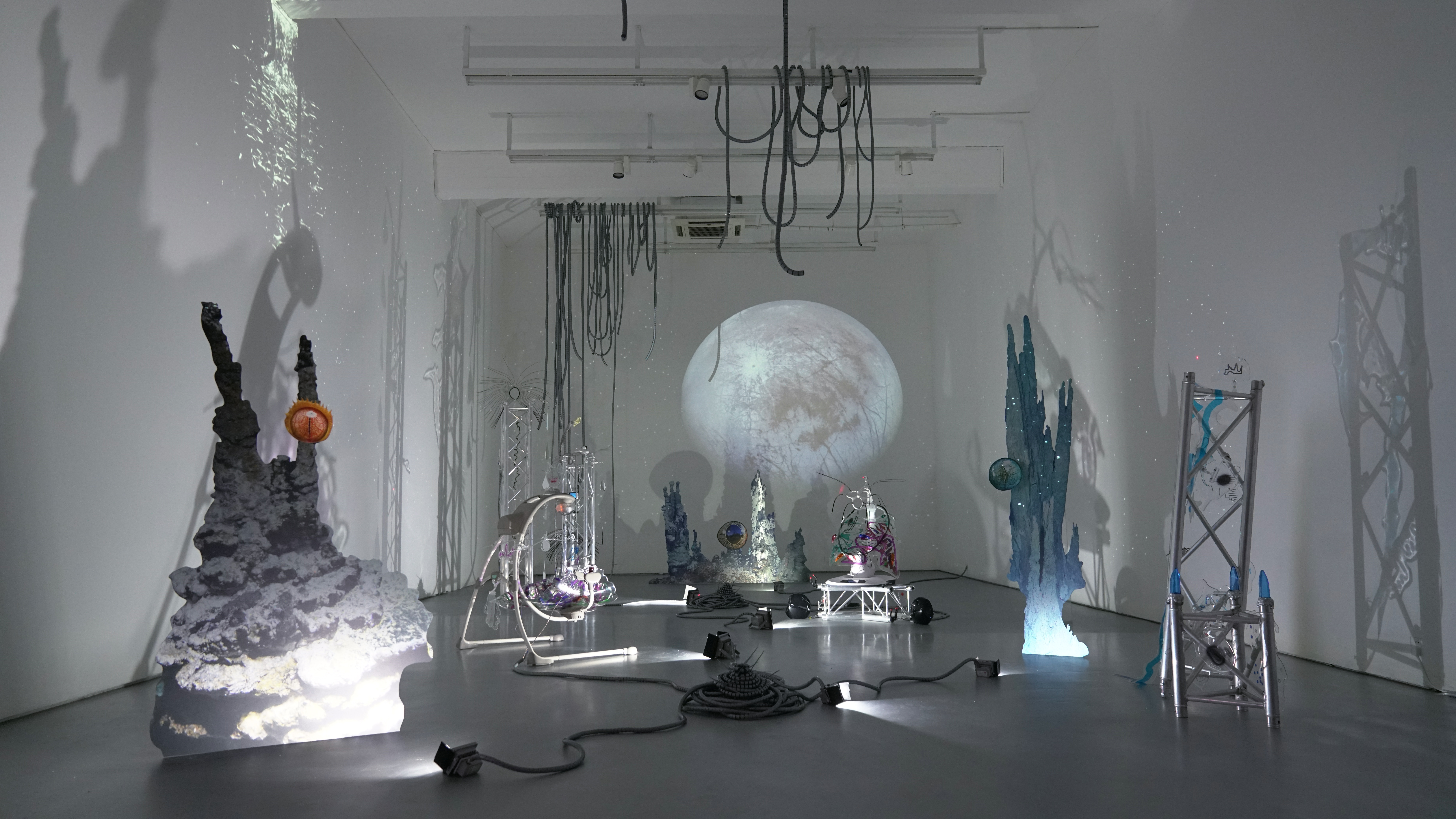
Installation View of Katja Novitskova: 洛基的城堡, Cc Art Foundation, Shanghai, 2017.
In the year 1119 AD, the renowned author Zhu Yu published his seminal work, the Pingzhou KeTan (萍洲可談), which provided a detailed account of the trade, customs, social exchanges, and early maritime technology utilized in China during the Song Dynasty. Of particular significance, the Pingzhou KeTan represents the earliest written record of the utilization of a mariner's magnetic-needle compass for navigation at sea.[1] In addition to outlining various maritime technologies, Zhu Yu also emphasized the importance of determining one's location while navigating oceanic space. He described technologies that employed samples of mud from the ocean floor, utilizing a series of cables and hooks, through which mariners could determine their whereabouts based on the appearance and smell of the mud.[2]
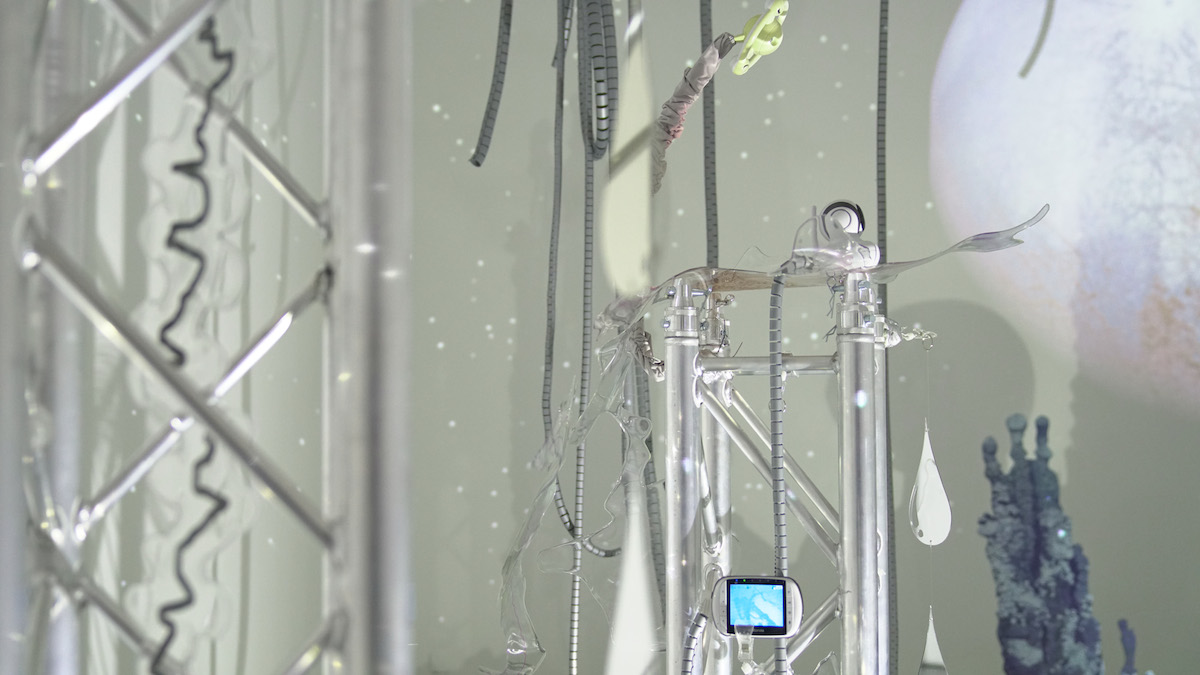
Installation View, Katja Novitskova: 洛基的城堡, Cc Art Foundation, Shanghai, 2017.
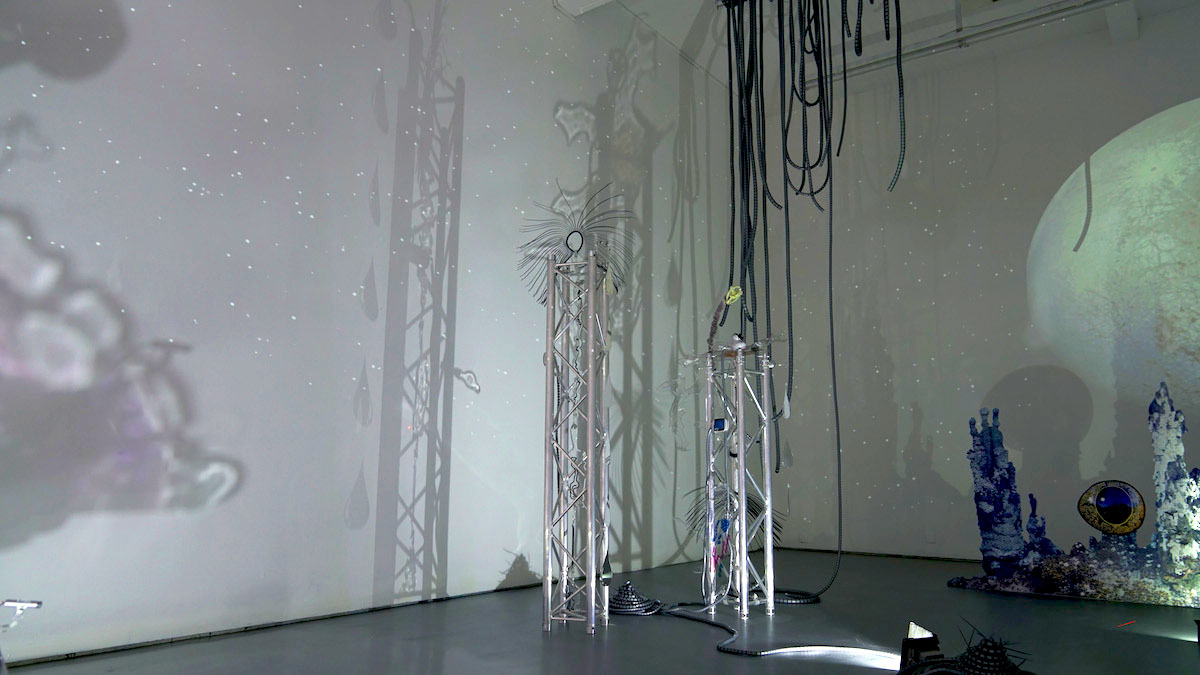 Installation View of Katja Novitskova: 洛基的城堡, Cc Art Foundation, Shanghai, 2017.
Installation View of Katja Novitskova: 洛基的城堡, Cc Art Foundation, Shanghai, 2017.889 years later, in the present day, technological advancements have greatly progressed, and companies no longer rely on human-occupied submersibles or vehicles connected by cables to surface ships for exploring the ocean floor. The development of robotic autonomous underwater vehicles, or AUVs, has enabled the comprehensive survey of vast areas of the undersea terrain for extended periods of time, with the capability of making autonomous decisions to avoid collisions with the ocean floor. [3]
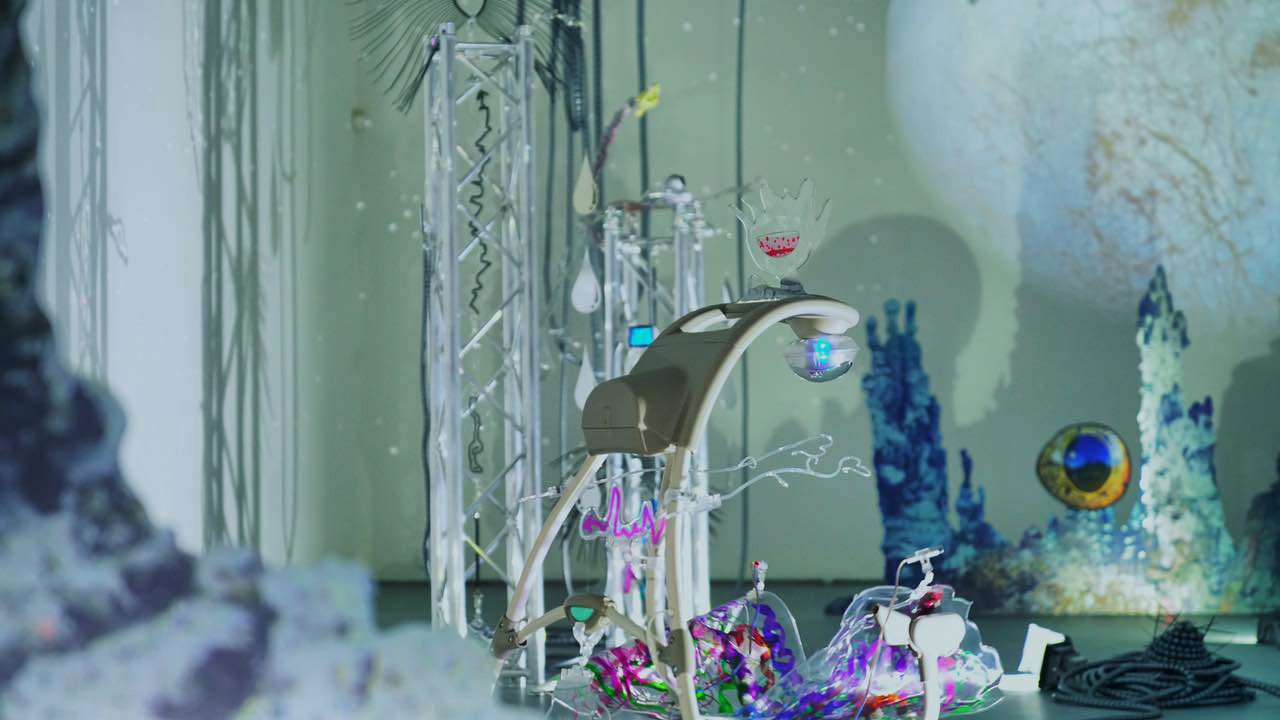
Installation View of Katja Novitskova: 洛基的城堡, Cc Art Foundation, Shanghai, 2017.
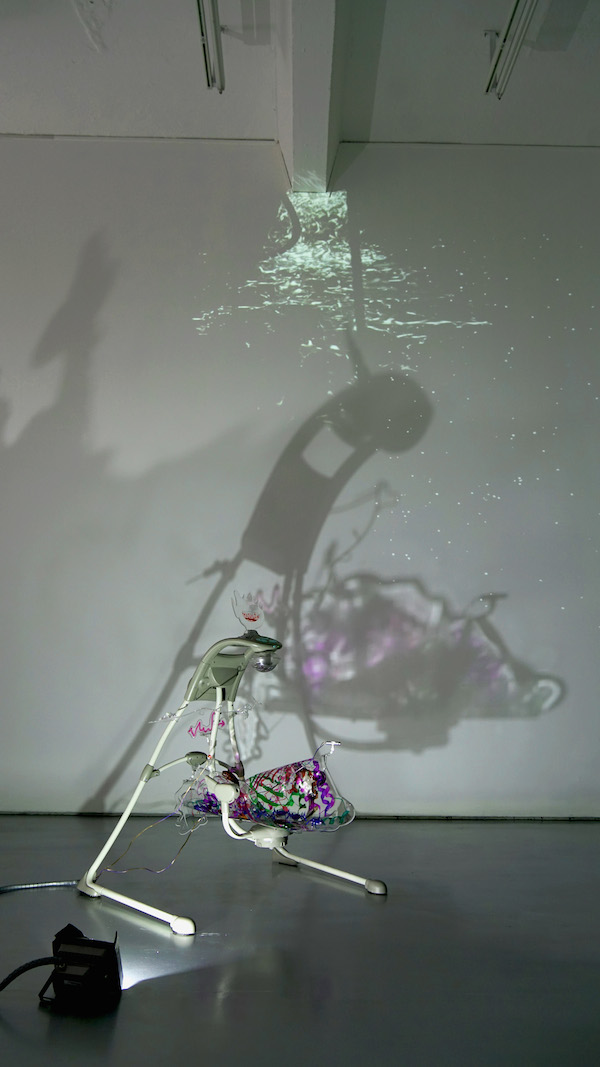
Installation View of Katja Novitskova: 洛基的城堡, Cc Art Foundation, Shanghai, 2017.
The centerpiece of the exhibition is Katja Novitskova's installation entitled "Loki's Castle" (2015), which presents a novel oceanic aesthetic through the utilization of sound, moving image, sculpture, and poetry to examine the deep-sea ecosystems on the ocean floor. Hydrothermal vents, discovered in the late 1970s by scientists studying a spreading oceanic ridge near the Galapagos Islands, have sparked what some have referred to as an undersea gold rush for precious metals, genetic material, and fossil fuels. Utilizing data from the economic and scientific exploration of these deep-sea territories, these discoveries are driving robotic and scientific development and providing a new frontier for colonial industrial expansion. Through the creation of an immersive environment, Novitskova explores the potential ontologies of these discoveries, such as the potential genetic linkages between planktonic microbial communities and the maritime technologies used to excavate these hydrothermal communities.
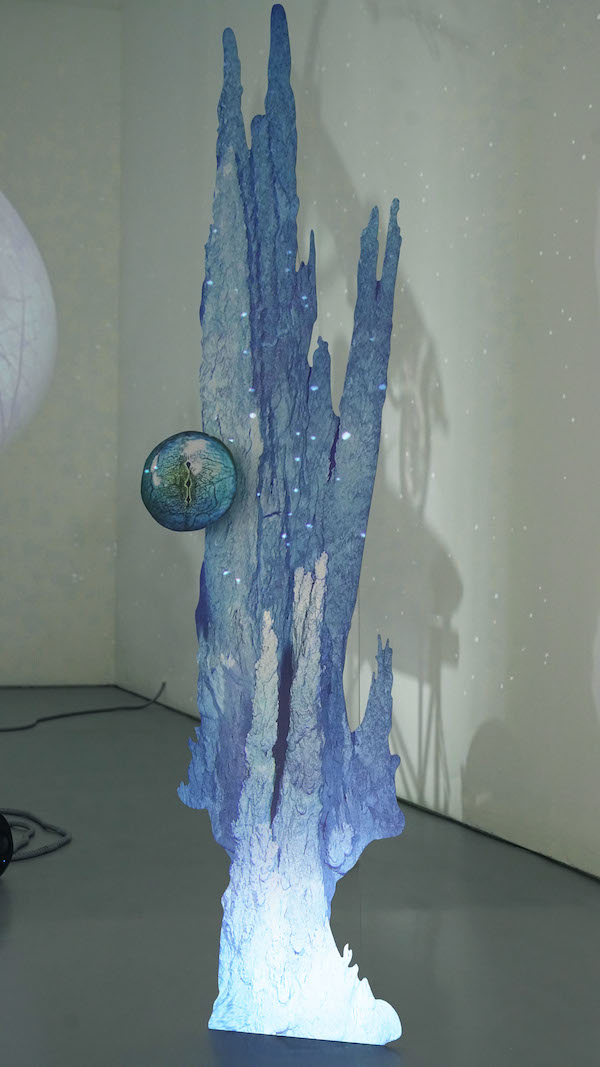
Installation View, Katja Novitskova: 洛基的城堡, Cc Art Foundation, Shanghai, 2017.
Upon the discovery of hydrothermal vents, scientists were astounded to find large numbers of previously unknown biological communities surrounding them. These microbes serve as the foundation for life in hydrothermal vent ecosystems. Notably, these organisms utilize a process known as chemosynthesis [4], in which they harvest chemical energy from minerals and chemical compounds that spew from the vents, as opposed to utilizing light energy to turn carbon dioxide into sugar, as is the case with plants.
With a plethora of potential industrial applications, such as in the pharmaceutical and mining industries, these newly discovered polysaccharide-producing microorganisms are expected to be utilized in many of these fields in the near future, and have sparked growing interest among various sectors of industry. With metals such as zinc and manganese, as well as rare earth materials such as cobalt, already being mined for use in high-tech devices like cell phones and computers, the potential for these microorganisms to contribute to these industries is significant.
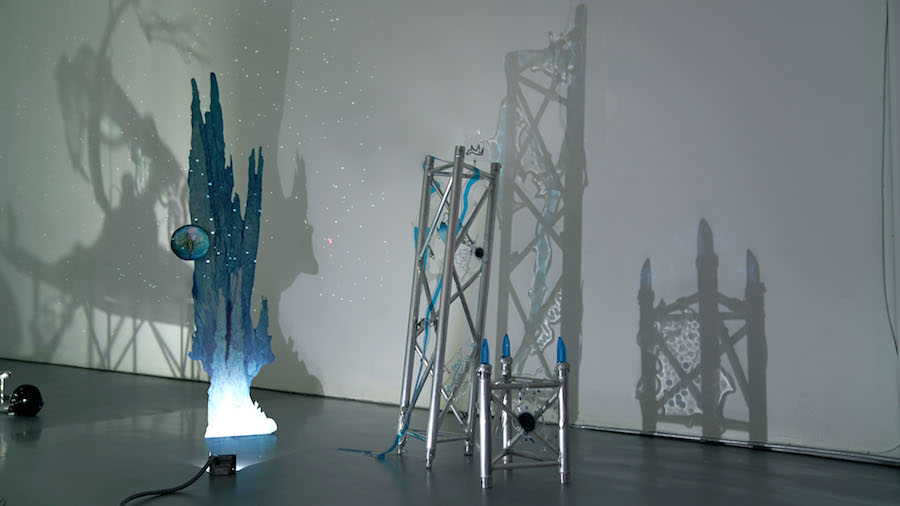
Installation View of Katja Novitskova: 洛基的城堡, Cc Art Foundation, Shanghai, 2017.
The study of oceanic connectivity and thinking has long been recognized as a fundamental source of knowledge and a benchmark for various civilizations and cultures worldwide. Furthermore, it has served as a crucial indicator and area of examination for scientists seeking to provide statistical data on climate change. Recent research indicates that there is a greater than 95 percent probability that the current warming trend is the result of human activity since the mid-20th century, and is proceeding at an unprecedented rate. [[5]] This evidence is often obtained through the utilization of advanced corporate and scientific technologies, which enable scientists to gain a comprehensive understanding of our planet and its climate on a global scale. Through the accumulation of data over a prolonged period of time, this body of research reveals the signals of a changing climate.
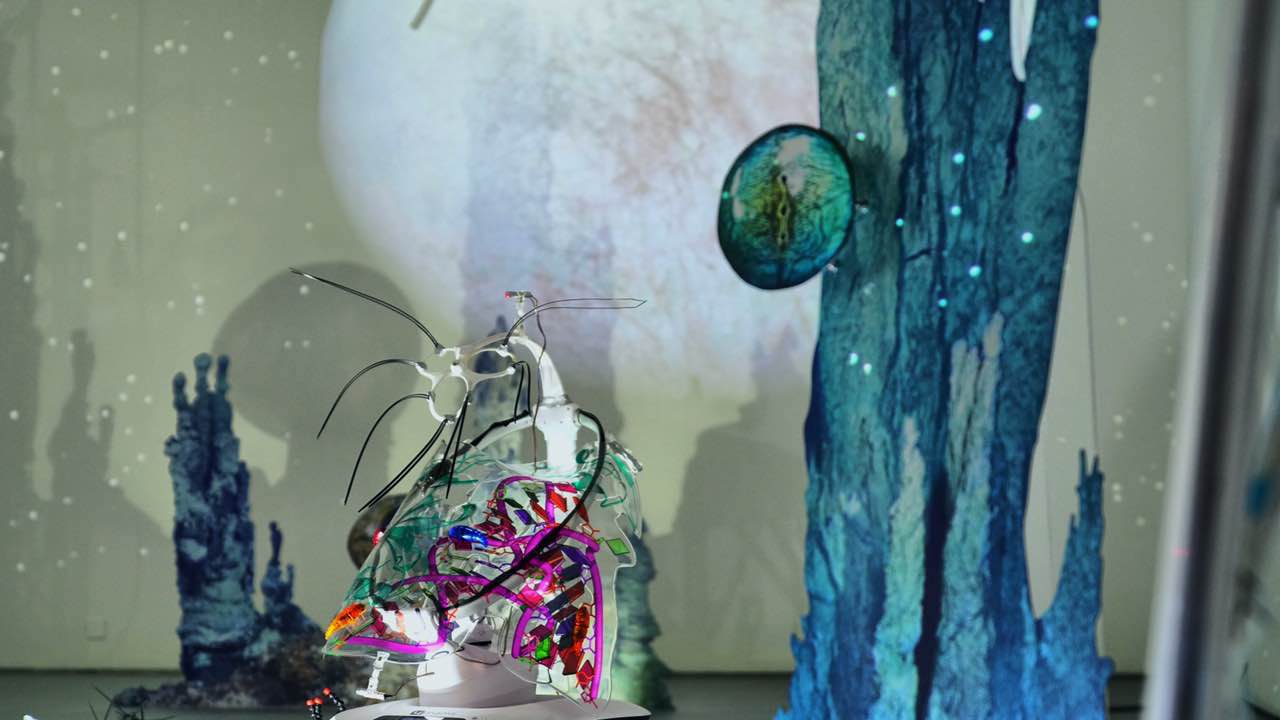
Installation View, Katja Novitskova: 洛基的城堡, Cc Art Foundation, Shanghai, 2017.
In Novitskova's installation, the realms of industry and biology converge to create a unique and dynamic synthesis. The replication of novel capabilities and chemical compositions within microbiological communities is showcased, highlighting their commercial potential. Furthermore, the installation envisions the continued diversity of expressions that these ecosystems may take in the near future. Novitskova, much like her contemporaries, presents a visual representation of the new frontier, seamlessly merging the various sub-currents that can be found intermingling under the extreme conditions of the deep ocean floor, such as high pressure, near-freezing temperatures, and pitch-black darkness.
Installation View, Katja Novitskova: 洛基的城堡, Cc Art Foundation, Shanghai, 2017.
Installation View, Katja Novitskova: 洛基的城堡, Cc Art Foundation, Shanghai, 2017.
Katja Novitskova: 洛基的城堡
Curated by Victor Wang
8 September - 19 November 2017
Venue: Cc Foundation & Art Centre
Room 101, Bldg 15, M50 Art Industrial Park, No.50 Moganshan Road, Putuo District, Shanghai, China
Cc Foundation & Art Centre is proud to present Katja Novitskova: 洛基的城堡 the first institutional solo exhibition in China by Estonian artist Katja Novitskova, curated by Victor Wang.
In the year 1119 AD, the renowned author Zhu Yu published his seminal work, the Pingzhou KeTan (萍洲可談), which provided a detailed account of the trade, customs, social exchanges, and early maritime technology utilized in China during the Song Dynasty. Of particular significance, the Pingzhou KeTan represents the earliest written record of the utilization of a mariner's magnetic-needle compass for navigation at sea.[1] In addition to outlining various maritime technologies, Zhu Yu also emphasized the importance of determining one's location while navigating oceanic space. He described technologies that employed samples of mud from the ocean floor, utilizing a series of cables and hooks, through which mariners could determine their whereabouts based on the appearance and smell of the mud.[2]
889 years later, in the present day, technological advancements have greatly progressed, and companies no longer rely on human-occupied submersibles or vehicles connected by cables to surface ships for exploring the ocean floor. The development of robotic autonomous underwater vehicles, or AUVs, has enabled the comprehensive survey of vast areas of the undersea terrain for extended periods of time, with the capability of making autonomous decisions to avoid collisions with the ocean floor. [3]
The centerpiece of the exhibition is Katja Novitskova's installation entitled "Loki's Castle" (2015), which presents a novel oceanic aesthetic through the utilization of sound, moving image, sculpture, and poetry to examine the deep-sea ecosystems on the ocean floor. Hydrothermal vents, discovered in the late 1970s by scientists studying a spreading oceanic ridge near the Galapagos Islands, have sparked what some have referred to as an undersea gold rush for precious metals, genetic material, and fossil fuels. Utilizing data from the economic and scientific exploration of these deep-sea territories, these discoveries are driving robotic and scientific development and providing a new frontier for colonial industrial expansion. Through the creation of an immersive environment, Novitskova explores the potential ontologies of these discoveries, such as the potential genetic linkages between planktonic microbial communities and the maritime technologies used to excavate these hydrothermal communities.
Upon the discovery of hydrothermal vents, scientists were astounded to find large numbers of previously unknown biological communities surrounding them. These microbes serve as the foundation for life in hydrothermal vent ecosystems. Notably, these organisms utilize a process known as chemosynthesis [4], in which they harvest chemical energy from minerals and chemical compounds that spew from the vents, as opposed to utilizing light energy to turn carbon dioxide into sugar, as is the case with plants.
With a plethora of potential industrial applications, such as in the pharmaceutical and mining industries, these newly discovered polysaccharide-producing microorganisms are expected to be utilized in many of these fields in the near future, and have sparked growing interest among various sectors of industry. With metals such as zinc and manganese, as well as rare earth materials such as cobalt, already being mined for use in high-tech devices like cell phones and computers, the potential for these microorganisms to contribute to these industries is significant.
The study of oceanic connectivity and thinking has long been recognized as a fundamental source of knowledge and a benchmark for various civilizations and cultures worldwide. Furthermore, it has served as a crucial indicator and area of examination for scientists seeking to provide statistical data on climate change. Recent research indicates that there is a greater than 95 percent probability that the current warming trend is the result of human activity since the mid-20th century, and is proceeding at an unprecedented rate. [[5]] This evidence is often obtained through the utilization of advanced corporate and scientific technologies, which enable scientists to gain a comprehensive understanding of our planet and its climate on a global scale. Through the accumulation of data over a prolonged period of time, this body of research reveals the signals of a changing climate.
Within Novitskova’s installation industry and biology meet, mix and re-form anew, replicating the novel capabilities and chemical compositions within these microbiological communities that make them so commercially attractive, imagining the continuing diversity of expressions that these eco-systems may take in the near future. Novitskova, like other artists of her generation, visualises the new frontier and combining the many sub-currents that can be found intermingling under the high pressure, near-freezing temperatures and pitch-black darkness at the frontier of the deep ocean floor.
About Cc Foundation
Cc Foundation was founded and supported by David Chau. With offices in both Hong Kong and Shanghai, the foundation currently runs two gallery spaces in Shanghai: one at Songjiang District and the other at M50 Art Zone - which presented its inaugural exhibition in November 2016.
The foundation is committed to supporting and sponsoring young and emerging cultural and art practitioners and collectives, encouraging innovative ideas and practices, fostering and improving the environment for cultural and art practitioners and promoting the development of Chinese contemporary culture, arts and art education.
Exhibition Reviews
+ Vice China - The Creators Project
《一种结合机器与生命体的新物种正在洛基的城堡中孕育》,陆冉,2017.09.14
http://thecreatorsproject.vice.cn/read/Katja-Novitskova-Loki-s-castle-at-Cc-foundation-Shanghai
+ The Art Newspaper China
《深潜“洛基的城堡”,进入诺维兹科娃构想的物种嬗变》,王晓芬,2017.09.09
http://dwz.cn/6wscZG
+ artron.net(雅昌艺术网)
《Cc艺术打造全新海洋美学:带你去看“洛基的城堡”》, 2017.09.11
http://news.artron.net/20170911/n956056.html
Chinese Version
Katja Novitskova:洛基的城堡
策展人:王宗孚
2017年9月8日-2017年11月19日
地点:Cc基金会 & 艺术中心
地址:上海市普陀区莫干山路50号M50创意园区15号楼101室
由知名藏家周大为先生创办并支持的Cc基金会和Cc艺术中心,很荣幸地宣布将于2017年9月8日至11月19日举办由爱沙尼亚艺术家——卡特娅·诺维兹科娃(Katja Novitskova)在中国的首次机构级别个展《Katja Novitskova: 洛基的城堡》,并由王宗孚先生担任策展人。
公元1119年,学者朱彧的著作《萍洲可谈》问世,书中详细介绍了宋代中国的商贸、习俗、社会交往和当时已被采用的早期航海技术。值得注意的是,《萍洲可谈》是磁针罗盘用于航海的最早书面记载[[1]]。朱彧不仅概述了多样的航海技术,还强调在大海航行中判断位置的重要性。他特别描述了对海底泥浆进行采样,然后利用一系列锚索和挂钩进行定位的技术:通过辨别泥浆的外形和气味,海员们可以从中判断出自己在海洋中所处的位置[[2]]。
889年后的今天,各类企业已不再需要通过缆绳与水面舰艇相连接的载人潜水器或水下航行工具来勘探海底。随着自主式水下潜器(AUV)的发展,人们已经能够对辽阔的海底进行耗时数天的勘察,充足的时间保证了合理的判断和决策,避免与海底地形发生冲撞[[3]]。
此次展览《Katja Novitskova: 洛基的城堡》呈现了诺维兹科娃的装置作品《洛基的城堡》(2015),它视像化了一种全新的海洋美学,并结合了声音、影像、雕塑和诗歌等多种形式,以此探索深海生态系统。20世纪70年代晚期,科学家们在研究加拉巴哥群岛附近大洋中脊的时候,首次发现了深海热泉(Hydrothermal Vents),这些深海热泉带来了新一轮的深海淘金热:利用来自深海领域的经济和科学研究数据,进行贵重金属、基因材料和化石燃料的采掘;这些发现推动了机器人和科学技术的发展,为殖民产业的扩张开辟了新的疆界。诺维兹科娃创作了一个沉浸式的环境,它为“当前本体论”提供了假设,例如,浮游微生物群落和用于挖掘海底热液生物群落的海洋技术之间潜在的演变关系。
让科学家们感到惊讶的是,他们在深海热泉附近发现了大量的、之前从未见过的生物群落。这些微生物是深海热泉生态系统中的生命基础。它们不像植物利用光能将二氧化碳转化为糖类有机物,而是攫取矿物质和化合物中产生的化学能,这些化学能从热泉口喷涌而出——完成了“化学合成”的过程[[4]]。产生多糖的新型微生物具备了从制药到采矿等多个工业领域的应用潜能,将在不久的将来实现多个领域的产业开发,而且这种需求与日俱增,比如锌和锰这类活性金属以及钴等稀土材料,已经被开采并广泛应用到手机、电脑等高科技设备中。
关于海洋科学的贯通性和思考早已成为学科之间的重要知识基础,是全球多元文明和文化的试金石。海洋同时也是科学家们试图提供气候变化统计数据的重要指标和监测地:根据最近的统计数据,有超过95%的概率说明目前全球变暖趋势是20世纪中期以来人类活动的结果,且仍在以前所未有的速度恶化[[5]]。企业发展和科技进步的深度结合使得科学家们能够获取这方面的证据,帮助他们在全球范围内搜集不同类型的信息,从而探知有关我们所处星球及其气候变化的更大真相。可以说,正是这种积累多年的数据体系揭示出了气候变化的信号。
在诺维兹科娃装置作品中,工业和生物碰撞相遇、交织融合,并最终蜕变新生。她重构了这些深海的微生物群落,它们因拥有新奇功能和独特化学构成而具有强大的商业吸引力。诺维兹科娃想象了在不久的未来,这些生态系统可能使用的持续和多样的表达方式。与同时代的艺术家一样,诺维兹科娃通过对深海海底中交错流淌于超高强度的压力、临近冰点的低温和浓重漆黑的晦暗之下蕴藏的无限可能进行重新想象,进而赋予这个崭新的海洋前沿领地其独特的艺术形象。
关于Cc基金会
Cc 基金会成立于香港和上海,由周大为先生创办与支持。目前在上海拥有两个专业艺术空间,一处位于松江,另一处空间位于M50艺术园区,于2016年11月初正式开幕。
Cc 基金会主要致力于积极促进中国当代文化艺术及教育事业的发展,长期赞助年轻的文化艺术工作者或团体,鼓励具有新观念的各种艺术形式,营造和改善有利于文化艺术工作者的环境氛围,以推动中国当代文化艺术事业的发展。
Cc 基金会将以回顾与发掘具有历史意义的展览,促进全球化当代艺术发展以及支持年轻艺术家创作及展示,推广周大为先生的兴趣和爱好为发展目标,逐步打造拥有国际级收藏规模的全球性艺术基金会。
[1] 路甬祥,《走进殿堂的 中国古代科技史》(Berlin; Heidelberg: Springer, 2015),II, p. 288
[2] 李约瑟,《中国科技文明史》,第4卷《物理学与物理技术》(台北市敦煌书局,1986),p.279
[3] 《深海机器人之死》,刊载于《今日物理学》(2010.3.9)网页地址:http://physicstoday.scitation.org/do/10.1063/PT.5.024143/full/(登陆于2017.2.8)
[4] Lisa A. Levin等,《深海热泉与甲烷渗透:反思影响范围》,刊载于《海洋科学前沿》(2016.3.19)网页地址:http://journal.frontiersin.org/article/10.3389/fmars.2016.00072/full.登陆于2017.2.8
[5] 美国航空航天局,《全球气候变化:地球的生命体征》,网页地址:https://climate.nasa.gov/evidence/登陆于2017.6.10
[1] Yongxiang Lu, A History of Chinese Science and Technology, 3 vols. (Berlin; Heidelberg: Springer, 2015), II, p. 288.
[2] Joseph Needham, Science and Civilization in China, Vol. 4: Physics and Physical Technology (Taipei: Caves Books Ltd, 1986), p.279.
[3] ‘Death of a Deep-sea Robot’, Physics Today (9 March 2010), available at: http://physicstoday.scitation.org/do/10.1063/PT.5.024143/full/. Accessed Feb. 8 2017.
[4] Lisa A. Levin et al., ‘Hydrothermal Vents and Methane Seeps: Rethinking the Sphere of Influence’, Frontiers in Marine Science (19 May 2016), available at: http://journal.frontiersin.org/article/10.3389/fmars.2016.00072/full. Accessed Feb. 8 2017.
[5] NASA, ‘Evidence’, in: Global Climate Change: Vital Signs of the Planet, available at: https://climate.nasa.gov/evidence/Accessed June 10 2017.
VICTOR WANG
All content property of © Victor Wang 2009 - 2024 All rights reserved -- BEIJING - LONDON.
All content property of © Victor Wang 2009 - 2024 All rights reserved -- BEIJING - LONDON.